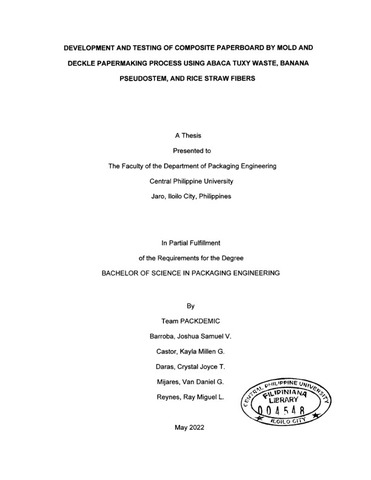Development and testing of composite paperboard by mold and deckle papermaking process using abaca tuxy waste, banana pseudostem, and rice straw fibers

Page views
2,051Petsa
2022-05May-akda
Tagapayo ng Tesis
Tagapangulo ng Panel ng Depensa
Magbahagi
Metadata
Ipakita ang buong tala ng item
Abstract
This research study determined the optimum ratio of abaca tuxy waste, banana pseudostem, and rice straw fibers to produce composite paperboard using the mold and deckle papermaking process. Four sets of composite paperboard sheets with varying fiber ratios were produced: (1) 33% abaca tuxy waste, 33% banana pseudostem, and 33% rice straw, (2) 50% abaca tuxy waste, 25% banana pseudostem, and 25% rice straw, (3) 25% abaca tuxy waste, 50% banana pseudostem, and 25% rice straw, and (4) 25% abaca tuxy waste, 25% banana pseudostem, and 50% rice straw. Among the four sets, Set 3 was found to be the best formulation, and Set 4 was found to be the closest to the solid unbleached board in terms of visual appearance. Results for bending stiffness showed that only Sets 2 and 4 were found to have no significant difference with solid unbleached board. For burst strength and tear strength results, all four sets showed no significant difference with solid unbleached board. Results for water absorbency showed that only Set 3 had a significant difference with solid unbleached board.
Paglalarawan
Abstract only
Mungkahing Sipi
Barroba, J. S. V. , Castor, K. M. G. , Daras, C. J. T. , Mijares, V. G. D. and Reynes, R. M. L. (2022). Development and testing of composite paperboard by mold and deckle papermaking process using abaca tuxy waste, banana pseudostem, and rice straw fibers (Unpublished special paper). Central Philippine University, Jaro, Iloilo City.
Uri
Special paperMga Paksa
Kagawaran
Packaging Engineering DepartmentDegree
Bachelor of Science in Packaging EngineeringLokasyon ng Istante
Filipiniana Theses 688.8072 B278
Pisikal na paglalarawan
xiii, 154 leaves


